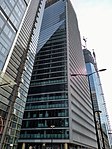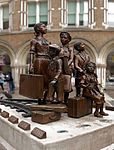St Botolph-without-Bishopsgate
18th-century Church of England church buildingsChurch of England church buildings in the City of LondonDiocese of LondonGrade II* listed churches in the City of LondonGreek Orthodox Church of Antioch ... and 2 more
Rebuilt churches in the United KingdomUse British English from February 2015

St Botolph-without-Bishopsgate is a Church of England church in the Bishopsgate Without area of the City of London, and also, by virtue of lying outside the city's (now demolished) eastern walls, part of London's East End. Adjoining the buildings is a substantial churchyard – running along the back of Wormwood Street, the former course of London Wall – and a former school. The church is linked with the Worshipful Company of Coopers and the Worshipful Company of Bowyers.
Excerpt from the Wikipedia article St Botolph-without-Bishopsgate (License: CC BY-SA 3.0, Authors, Images).St Botolph-without-Bishopsgate
White Hart Court, City of London
Geographical coordinates (GPS) Address External links Nearby Places Show on map
Geographical coordinates (GPS)
| Latitude | Longitude |
|---|---|
| N 51.516708333333 ° | E -0.081655555555556 ° |
Address
St Botolph-without-Bishopsgate
White Hart Court
EC2M 7PP City of London
England, United Kingdom
Open on Google Maps









